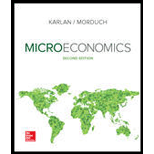
(a)
To find the cross-
Answer to Problem 18PA
The cross-price elasticity is -0.5 and goods are complements.
Explanation of Solution
Cross-price elasticity measures the degree of responsiveness of a change in the quantity demanded of a good for a given change in the price of some other good.
It is calculated by dividing the percentage change in the quantity demanded of one good by the percentage change in the price of the other good.
When an increase in price of one good leads to an increase in the quantity demanded of the other good, then the goods are close substitute of each other. The cross-price elasticity is positive in this case.
However, when an increase in price of one good leads to adecrease in the quantity demanded of the other good, then the goods are complementarygoods. The cross-price elasticity is negative in this case.
Initial price of peanut butter (P1) = $2
Final price of peanut butter (P2) = $3
Initial quantity of jelly (Q1) = 20
Final quantity of jelly (Q2) = 15
The percentage change in price of peanut butter is:
The percentage change in the quantity demanded of jelly is:
Cross-
Since, the cross-price elasticity is negative. Thus, goods are complements.
(b)
To find the cross-price elasticity and check whether the goods are complements or substitutes.
Answer to Problem 18PA
The cross-price elasticity is +0.6 and goods are substitutes.
Explanation of Solution
Cross-price elasticity measures the degree of responsiveness of a change in the quantity demanded of a good for a given change in the price of some other good.
It is calculated by dividing the percentage change in the quantity demanded of one good by the percentage change in the price of the other good.
When an increase in price of one good leads to an increase in the quantity demanded of the other good, then the goods are close substitute of each other. The cross-price elasticity is positive in this case.
However, when an increase in price of one good leads to a decrease in the quantity demanded of the other good, then the goods are complementary goods. The cross-price elasticity is negative in this case.
Initial price of peanut butter (P1) = $2
Final price of peanut butter (P2) = $3
Initial quantity of jelly (Q1) = 15
Final quantity of jelly (Q2) = 20
The percentage change in price of peanut butter is:
The percentage change in the quantity demanded of jelly is:
Cross-price
Since, the cross-price elasticity is positive. Thus, goods are substitutes.
Want to see more full solutions like this?
Chapter 4 Solutions
Microeconomics
- Answerarrow_forwardM” method Given the following model, solve by the method of “M”. (see image)arrow_forwardAs indicated in the attached image, U.S. earnings for high- and low-skill workers as measured by educational attainment began diverging in the 1980s. The remaining questions in this problem set use the model for the labor market developed in class to walk through potential explanations for this trend. 1. Assume that there are just two types of workers, low- and high-skill. As a result, there are two labor markets: supply and demand for low-skill workers and supply and demand for high-skill workers. Using two carefully drawn labor-market figures, show that an increase in the demand for high skill workers can explain an increase in the relative wage of high-skill workers. 2. Using the same assumptions as in the previous question, use two carefully drawn labor-market figures to show that an increase in the supply of low-skill workers can explain an increase in the relative wage of high-skill workers.arrow_forward
- Published in 1980, the book Free to Choose discusses how economists Milton Friedman and Rose Friedman proposed a one-sided view of the benefits of a voucher system. However, there are other economists who disagree about the potential effects of a voucher system.arrow_forwardThe following diagram illustrates the demand and marginal revenue curves facing a monopoly in an industry with no economies or diseconomies of scale. In the short and long run, MC = ATC. a. Calculate the values of profit, consumer surplus, and deadweight loss, and illustrate these on the graph. b. Repeat the calculations in part a, but now assume the monopoly is able to practice perfect price discrimination.arrow_forwardThe projects under the 'Build, Build, Build' program: how these projects improve connectivity and ease of doing business in the Philippines?arrow_forward
 Economics Today and Tomorrow, Student EditionEconomicsISBN:9780078747663Author:McGraw-HillPublisher:Glencoe/McGraw-Hill School Pub Co
Economics Today and Tomorrow, Student EditionEconomicsISBN:9780078747663Author:McGraw-HillPublisher:Glencoe/McGraw-Hill School Pub Co Economics (MindTap Course List)EconomicsISBN:9781337617383Author:Roger A. ArnoldPublisher:Cengage Learning
Economics (MindTap Course List)EconomicsISBN:9781337617383Author:Roger A. ArnoldPublisher:Cengage Learning
 Managerial Economics: A Problem Solving ApproachEconomicsISBN:9781337106665Author:Luke M. Froeb, Brian T. McCann, Michael R. Ward, Mike ShorPublisher:Cengage Learning
Managerial Economics: A Problem Solving ApproachEconomicsISBN:9781337106665Author:Luke M. Froeb, Brian T. McCann, Michael R. Ward, Mike ShorPublisher:Cengage Learning





